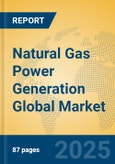Industry Characteristics
Natural gas power generation is defined by its efficiency and flexibility, with combined cycle plants achieving up to 60% thermal efficiency compared to coal’s 40%. The industry leverages advanced turbine technologies, such as aeroderivative and heavy-duty gas turbines, to optimize performance. It operates within a complex ecosystem of fuel supply, power plant operations, and grid integration, requiring robust infrastructure for gas extraction, transport, and storage. Like antioxidants stabilizing polymers, natural gas stabilizes energy grids by providing rapid-response capacity to counter renewable variability. The sector is capital-intensive, with high upfront costs offset by long-term operational efficiency. Regulatory frameworks, including emissions standards and carbon pricing, shape investment, while technological advancements like carbon capture integration aim to align with net-zero goals. Demand is driven by urbanization, industrial growth, and the global shift from coal, particularly in emerging economies.Regional Market Trends
The market’s growth varies by region, reflecting resource availability, energy policies, and infrastructure development.- North America: Growth is projected at 2.0%-6.0% CAGR through 2030. The U.S. leads with its shale gas boom, driving combined cycle plant expansions. Canada’s growth is tied to LNG exports and domestic power needs, though renewable mandates temper expansion.
- Europe: Europe anticipates a 1.5%-5.5% CAGR. Germany and the UK prioritize gas as a coal phase-out bridge, with cogeneration gaining traction in district heating. EU’s taxonomy for sustainable finance supports gas with carbon capture, but stringent emissions rules challenge growth.
- Asia-Pacific (APAC): APAC leads with a 3.0%-8.0% CAGR. China’s coal-to-gas shift and India’s industrial demand drive growth, with Japan focusing on LNG-based plants post-Fukushima. Southeast Asia’s gas infrastructure investments bolster regional demand.
- Latin America: The market expects a 2.5%-6.5% CAGR. Brazil leverages offshore gas fields, while Mexico expands combined cycle plants. Economic volatility limits broader adoption, but energy security drives investments.
- Middle East and Africa (MEA): MEA projects a 3.0%-7.0% CAGR. Saudi Arabia and the UAE use gas for diversification from oil, while Nigeria’s gas-to-power initiatives support industrialization. Infrastructure gaps remain a hurdle.
Application Analysis
Applications include Power Utilities, Industrial, and Residential & Commercial, each with unique dynamics.- Power Utilities: The largest segment, with a 2.5%-7.0% CAGR, focuses on grid-scale electricity. Combined cycle plants dominate, with trends toward hybrid systems integrating renewables for grid resilience.
- Industrial: Growing at 2.0%-6.5%, this segment powers manufacturing and petrochemicals. Cogeneration is a key trend, improving energy efficiency by 20% through waste heat utilization.
- Residential & Commercial: With a 1.5%-5.5% CAGR, this segment supports district heating and small-scale CHP units. Trends include microgrids for urban energy resilience.
Company Landscape
Key players dominate through turbine technology and global reach.- General Electric (GE Vernova): GE’s advanced gas turbines lead in efficiency, serving global utilities with carbon capture solutions.
- Siemens Energy: Siemens excels in combined cycle systems, with a focus on digital twins for plant optimization.
- Mitsubishi Power: A leader in high-efficiency turbines, Mitsubishi supports APAC’s LNG-based plants.
- Ansaldo Energia: Italy-based Ansaldo focuses on flexible gas solutions for Europe’s energy transition.
- Wärtsilä Corporation: Wärtsilä specializes in modular gas engines for industrial and remote applications.
Industry Value Chain Analysis
The value chain spans gas extraction to electricity delivery. Upstream, natural gas is sourced via drilling or LNG imports, requiring pipeline infrastructure. Manufacturing involves turbine and generator production, with firms like GE leveraging advanced materials. Distribution includes EPC contractors and grid operators, while downstream utilities deliver power to end-users. The chain emphasizes efficiency and emissions compliance, with digital tools optimizing operations.Opportunities and Challenges
Opportunities include natural gas’s role as a transition fuel, infrastructure modernization, and cogeneration growth. Challenges encompass regulatory pressure for decarbonization, competition from renewables, and geopolitical risks affecting gas supply.This product will be delivered within 1-3 business days.
Table of Contents
Companies Mentioned
- General Electric (GE Vernova)
- Siemens Energy
- Mitsubishi Power
- Ansaldo Energia
- Harbin Electric
- Shanghai Electric
- Doosan Heavy Industries
- MAN Energy Solutions
- Wärtsilä Corporation








